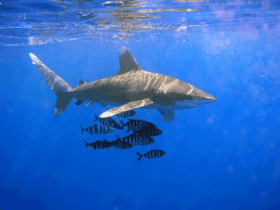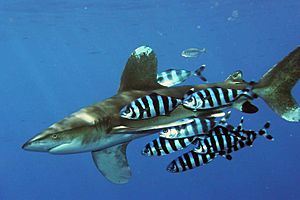Oceanic whitetip shark facts for kids
Quick facts for kids Oceanic whitetip shark |
|
|---|---|
 |
|
| Conservation status | |
| Scientific classification | |
| Kingdom: | |
| Phylum: | |
| Class: | |
| Order: | |
| Family: | |
| Genus: | |
| Species: |
C. longimanus
|
| Binomial name | |
| Carcharhinus longimanus |
|
 |
|
| Range of the Oceanic whitetip shark | |

The Oceanic whitetip shark (Carcharhinus longimanus) is a large type of shark known as a requiem shark. It belongs to the Carcharhinus group. These sharks can grow up to 4 meters (about 13 feet) long and weigh as much as 170 kg (370 pounds). You can easily tell them apart from other sharks by their big, rounded first dorsal fin and their very long, wide, paddle-like pectoral fins.
It's important not to confuse the Oceanic whitetip shark with the Whitetip reef shark, which is a different species.
Contents
About the Oceanic Whitetip Shark
The Oceanic whitetip shark is quite easy to spot because of its unique fins. It has a large, rounded first dorsal fin located just in front of its pectoral fins. Its pectoral fins are also very long and wide, looking a bit like paddles. The second dorsal fin is found near the anal fin.
This shark gets its name from the whitish tips on its first dorsal, pectoral, pelvic, and caudal fins. The underside of its body is usually white, and some sharks might have a yellowish tint.
Oceanic whitetip sharks can become quite large. The biggest ones recorded were about 3.5 to 4 meters (12-13 feet) long. However, most of these sharks are usually less than 3 meters (10 feet) long. The heaviest one ever recorded weighed 170 kg (370 pounds). Male sharks become adults when they are about 1.7-1.9 meters (5.6-6.2 feet) long. Females mature at a slightly larger size, around 1.8-2 meters (5.9-6.6 feet).
Where Oceanic Whitetip Sharks Live
These sharks live in many parts of the world's oceans. In the western Atlantic Ocean, you can find them from Maine in the United States all the way to Argentina. This includes the Gulf of Mexico and the Caribbean Sea. In the eastern Atlantic, they live from Portugal to the Gulf of Guinea. They might even be found in the Mediterranean Sea.
In the Indo-Pacific region, they are found from the Red Sea and East Africa to islands like Hawaii, Samoa, Tahiti, and Tuamoto. In the eastern Pacific Ocean, they range from southern California to Peru, including the Galápagos Islands.
This shark usually lives far from land in deep ocean waters, sometimes as deep as 152 meters (500 feet). Sometimes, they come closer to shore, especially near oceanic islands. Studies in the Pacific Ocean show that more of these sharks are found the further you go from land. They are one of the three most common sharks in the open ocean, along with the Blue shark and the Silky shark. Oceanic whitetip sharks are very common in areas where the water temperature is above 21°C (70 °F).
Even though they usually swim alone, Oceanic whitetip sharks will gather in groups when there is a lot of food. They are slow swimmers and are active both day and night. They are often seen swimming slowly near the surface with their pectoral fins spread wide. These sharks are often joined by other sea creatures like remoras, dolphinfish, and pilot fish. Sometimes, they have even been seen swimming with pods of Shortfin pilot whales in Hawaiian waters. Scientists think this might be because the pilot whales are good at finding squid, which the sharks also like to eat.
How Oceanic Whitetip Sharks Behave

The Oceanic whitetip shark mostly swims alone and slowly. It often cruises near the top of the water, covering large areas to find food. Sailors used to call sharks "sea dogs" before the 16th century. The Oceanic whitetip shark, which often follows ships, can act a bit like a dog when it smells food. It will swim eagerly towards the food source, approaching carefully but not giving up. If it's scared away, it keeps a safe distance but is ready to rush back if it gets a chance.
These sharks are not known for being fast swimmers, but they can have surprising bursts of speed. They often compete with Silky sharks for food and can show aggressive actions. It seems that male and female sharks, and sharks of different sizes, do not separate into different groups. Oceanic whitetip sharks often follow schools of tuna or squid. They also trail groups of dolphins and pilot whales, hoping to eat any leftover prey.
What Oceanic Whitetip Sharks Eat
Oceanic whitetip sharks mainly eat bony fish, such as lancetfish, oarfish, barracuda, jacks, dolphinfish, marlin, tuna, mackerels, and threadfins. They also eat other things like stingrays, sea turtles, sea birds, snails, squid, crabs and lobsters, and even dead mammals like whales and dolphins.
These sharks have been seen biting into schools of fish. They also swim through groups of feeding tuna with their mouths wide open, sometimes catching tuna that swim right in. Oceanic whitetip sharks have even been seen eating garbage thrown into the sea. If they meet other shark species while feeding, the Oceanic whitetip shark usually becomes aggressive and takes charge.
Reproduction and Life Cycle
In the north-western Atlantic Ocean and the south-western Indian Ocean, Oceanic whitetip sharks are known to mate in the early summer. After being pregnant for about one year, the female shark gives birth to 1 to 15 pups.
The Oceanic whitetip shark is viviparous, which means the pups develop inside the mother and are born live, rather than hatching from eggs. Both male and female sharks become adults when they are around 6-7 years old. Females are about 1.8-2 meters (5.9-6.6 feet) long when they mature, and males are about 1.7-1.9 meters (5.6-6.2 feet) long. The young sharks are about 60-65 cm (2 feet) long when they are born.
Oceanic Whitetip Sharks and Humans
Oceanic whitetip sharks are often caught by people who fish for sharks. Their meat is sold fresh, frozen, smoked, or dried and salted for people to eat. Their skin is used to make leather, their fins are used in shark-fin soup, and oil from their liver is used for vitamins. They are also processed into fishmeal, which is used for animal feed.
Tuna fishermen don't like Oceanic whitetip sharks because these sharks are known to follow tuna boats and can damage or eat the fish that have been caught. Even though these sharks are usually found far from shore, they are considered to be dangerous. They are often the first sharks to appear in the water when there's a disaster in the open ocean. For example, during World War II, a ship called the Nova Scotia sank off the coast of South Africa. Many people were in the water, and it is believed that Oceanic whitetip sharks were involved, showing their opportunistic feeding behavior.
When divers meet Oceanic whitetip sharks, the sharks often show little fear. They usually investigate and swim around what's happening. Because these sharks are bold, unpredictable, and will eat whatever they can find, divers should be extremely careful around them. Many accidental bites happen when divers bump into the shark.
The Oceanic whitetip shark is listed as 'vulnerable' overall, meaning its population is decreasing. However, in the north-western and western-central Atlantic Ocean, the IUCN has listed it as 'critically endangered'. This is because reports show a huge drop in the number of these sharks caught, which means their population has gone down a lot.
Images for kids
-
Oceanic whitetip with a rusty fish hook in its mouth
See also
 In Spanish: Tiburón oceánico para niños
In Spanish: Tiburón oceánico para niños





